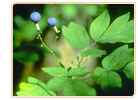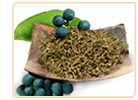Blue Cohosh
 Blue and black cohosh, although similar in name, are not of the same plant species. Interestingly, these plants do have similar traits when being used as an herbal supplement. It is important to identify the differences between these two herbs because one might help treat a medical problem, while the other may cause adverse effects, depending on the consumer's general health. Blue and black cohosh, although similar in name, are not of the same plant species. Interestingly, these plants do have similar traits when being used as an herbal supplement. It is important to identify the differences between these two herbs because one might help treat a medical problem, while the other may cause adverse effects, depending on the consumer's general health.
Keep reading to learn more about the blue cohosh herb and its differences to the more commonly used black cohosh herb.
Difference between Blue Cohosh and Black Cohosh
 Blue cohosh is native to North America and is usually found along its east coast. Its Latin name is Caulophyllum thalictroides, but it is also known as blue ginseng, papoose root, yellow ginseng, blueberry root, and beech drops. Blue cohosh is native to North America and is usually found along its east coast. Its Latin name is Caulophyllum thalictroides, but it is also known as blue ginseng, papoose root, yellow ginseng, blueberry root, and beech drops.
Most supplements use only one part of blue cohosh - its roots. The plant is identifiable by its bluish-green color and blue fruits. These plants usually grow between one and three feet high and are purple in color when young. It is easy to recognize blue cohosh from black cohosh because, as the name suggests, black cohosh has dark brown or black roots.
Read on to learn more about the uses, benefits, and side effects of blue cohosh.
Common Uses of Blue Cohosh
 Blue cohosh can be taken as a supplement in pill form or even brewed to form tea. Blue cohosh can be taken as a supplement in pill form or even brewed to form tea.
Blue Cohosh is most commonly known as a treatment for menopausal and menstrual problems, and it has also been used to induce labor in heavily pregnant women.
Benefits of Blue Cohosh
Originally used by Native American tribes as a medicinal herb, blue cohosh was believed to help fight illness in a similar way to black cohosh. Epilepsy, rheumatism, and irregular menstrual cycles were all thought to be treatable with blue cohosh.
Though, the benefits of blue cohosh do not come without some side effects; keep reading below to learn more about these.
Safety and Side Effects of the Blue Cohosh Herb
The differences between blue and black cohosh become apparent when the side effects of these herbs are considered. Whilst both plants need further research and testing, problems have occurred from their use in some patients.
Blue and black cohosh can cause stomach and intestinal problems or at least worsen any existing conditions a person may have. High blood pressure may also become more serious after blue cohosh consumption. For these reasons, it is best to consult a doctor before including blue cohosh in your diet.
 As stated above, blue cohosh has been used in the past as a labor-inducing supplement. It has similar effects on pregnant women who are not nearing their due date; miscarriage or false labor pains can result if blue cohosh is taken by a pregnant woman who is not nearing the end of her pregnancy. As stated above, blue cohosh has been used in the past as a labor-inducing supplement. It has similar effects on pregnant women who are not nearing their due date; miscarriage or false labor pains can result if blue cohosh is taken by a pregnant woman who is not nearing the end of her pregnancy.
A substance in the blue cohosh root has been identified as being similar to nicotine, so much so that it is potentially toxic and could be dangerous when consumed regularly.
Overall, blue cohosh is considered by many to be less reliable and certainly more dangerous than black cohosh. Undoubtedly, in the treatment of menopausal symptoms such as hot flashes and mood swings, black cohosh is far more effective.
Now that the differences between black cohosh and the blue cohosh extract have been explained, click this link to learn more about the way in which black cohosh works.
Conclusions about Blue Cohosh
Although blue cohosh has been used to treat some menopause symptoms in the past, it has come under criticism for triggering serious side effects such as breast cancer. Furthermore, the high levels of toxic chemicals found in blue cohosh mean that it is not widely used as an herbal supplement today.
Other alternative treatments can be more effective than blue cohosh, without the side effects. Non-estrogenic herbs, for example, are a great option for treating menopause symptoms. Read more in the following article.
Which herb should women try? Today women are looking for relief from their menopause symptoms with herbs. Phytoestrogenic herbs and non-estrogenic herbs are good in relieving menopause symptoms, but recent studies show that non-estrogenic herbs have no side effects because they help the body to produce its own hormones instead of introducing hormones like the phytoestrogenic ones. Learn more about non-estrogenic herbs for menopause. | 

